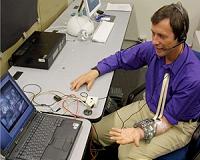| . |  |
. |
Durham NC (SPX) Jun 10, 2010 A new study pinpoints the genetic changes that enable Tibetans to thrive at altitudes where others get sick. In the online edition of Proceedings of the National Academy of Sciences, an international team has identified a gene that allows Tibetans to live and work more than two miles above sea level without getting altitude sickness. A previous study published May 13 in Science reported that Tibetans are genetically adapted to high altitude. Now, less than a month later, a second study by scientists from China, England, Ireland, and the United States pinpoints a particular site within the human genome - a genetic variant linked to low hemoglobin in the blood - that helps explain how Tibetans cope with low-oxygen conditions. The study sheds light on how Tibetans, who have lived at extreme elevation for more than 10,000 years, have evolved to differ from their low-altitude ancestors. Lower air pressure at altitude means fewer oxygen molecules for every lungful of air. "Altitude affects your thinking, your breathing, and your ability to sleep. But high-altitude natives don't have these problems," said co-author Cynthia Beall of Case Western Reserve University. "They're able to live a healthy life, and they do it completely comfortably," she said. People who live or travel at high altitude respond to the lack of oxygen by making more hemoglobin, the oxygen-carrying component of human blood. "That's why athletes like to train at altitude. They increase their oxygen-carrying capacity," said Beall. But too much hemoglobin can be a bad thing. Excessive hemoglobin is the hallmark of chronic mountain sickness, an overreaction to altitude characterized by thick and viscous blood. Tibetans maintain relatively low hemoglobin at high altitude, a trait that makes them less susceptible to the disease than other populations. "Tibetans can live as high as 13,000 feet without the elevated hemoglobin concentrations we see in other people," said Beall. To pinpoint the genetic variants underlying Tibetans' relatively low hemoglobin levels, the researchers collected blood samples from nearly 200 Tibetan villagers living in three regions high in the Himalayas. When they compared the Tibetans' DNA with their lowland counterparts in China, their results pointed to the same culprit - a gene on chromosome 2, called EPAS1, involved in red blood cell production and hemoglobin concentration in the blood. Originally working separately, the authors of the study first put their findings together at a March 2009 meeting at the National Evolutionary Synthesis Center in Durham, NC. "Some of us had been working on the whole of Tibetan DNA. Others were looking at small groups of genes. When we shared our findings we suddenly realized that both sets of studies pointed to the same gene - EPAS1," said Robbins, who co-organized the meeting with Beall. While all humans have the EPAS1 gene, Tibetans carry a special version of the gene. Over evolutionary time individuals who inherited this variant were better able to survive and passed it on to their children, until eventually it became more common in the population as a whole. "This is the first human gene locus for which there is hard evidence for genetic selection in Tibetans," said co-author Peter Robbins of Oxford University. Researchers are still trying to understand how Tibetans get enough oxygen to their tissues despite low levels of oxygen in the air and bloodstream. Until then, the genetic clues uncovered so far are unlikely to be the end of the story. "There are probably many more signals to be characterized and described," said co-author Gianpiero Cavalleri of the Royal College of Surgeons in Ireland. For those who live closer to sea level, the findings may one day help predict who is at greatest risk for altitude sickness. "Once we find these versions, tests can be developed to tell if an individual is sensitive to low-oxygen," said co-author Changqing Zeng of the Beijing Institute of Genomics. "Many patients, young and old, are affected by low oxygen levels in their blood -perhaps from lung disease, or heart problems. Some cope much better than others," said co-author Hugh Montgomery, of University College London. "Studies like this are the start in helping us to understand why, and to develop new treatments." The team's findings will be published online the week of June 7 in Proceedings of the National Academy of Sciences. CITATION: Beall, C., G. Cavalleri, et al. (2010). "Natural selection on EPAS1 (HIF2a) associated with low hemoglobin concentration in Tibetan highlanders." Proceedings of the National Academy of Sciences.
Share This Article With Planet Earth
Related Links National Evolutionary Synthesis Center (NESCent) All About Human Beings and How We Got To Be Here
 Commentary: Singularity is here
Commentary: Singularity is hereWashington (UPI) Jun 4, 2010 He speaks nine languages, taught himself Icelandic in a week and invented his own language he calls Manti. The 31-year-old autistic savant does complex celestial computations in seconds, sees hundreds of numbers on a blackboard once and can recite them in the correct sequence minutes later. Daniel Tammet possesses synesthesia. Not only does he see numbers but also feels them. He is one ... read more |
|
| The content herein, unless otherwise known to be public domain, are Copyright 1995-2010 - SpaceDaily. AFP and UPI Wire Stories are copyright Agence France-Presse and United Press International. ESA Portal Reports are copyright European Space Agency. All NASA sourced material is public domain. Additional copyrights may apply in whole or part to other bona fide parties. Advertising does not imply endorsement,agreement or approval of any opinions, statements or information provided by SpaceDaily on any Web page published or hosted by SpaceDaily. Privacy Statement |